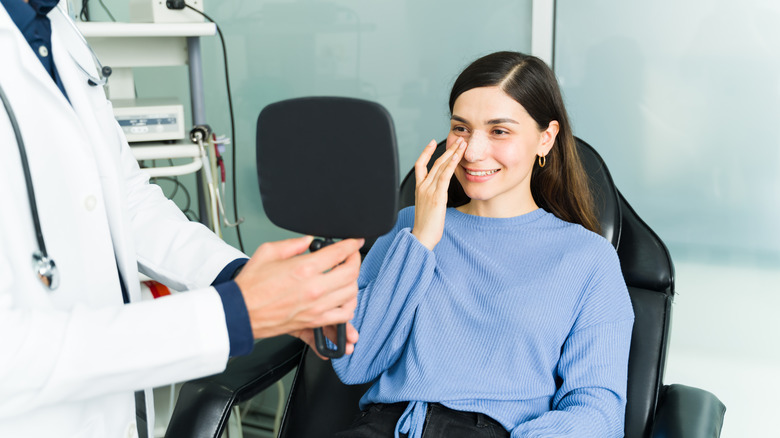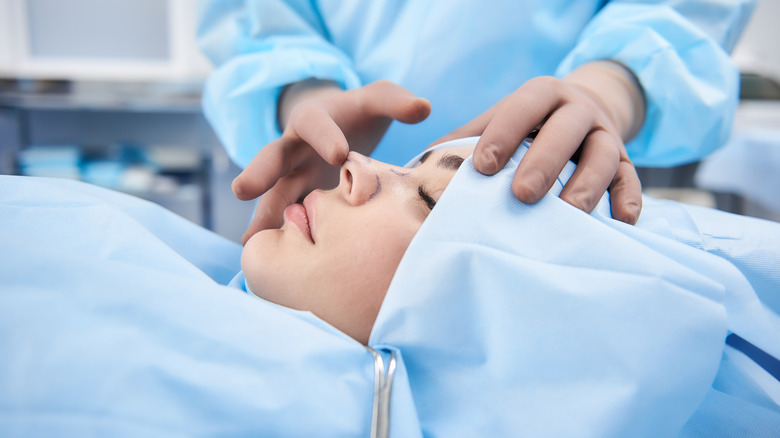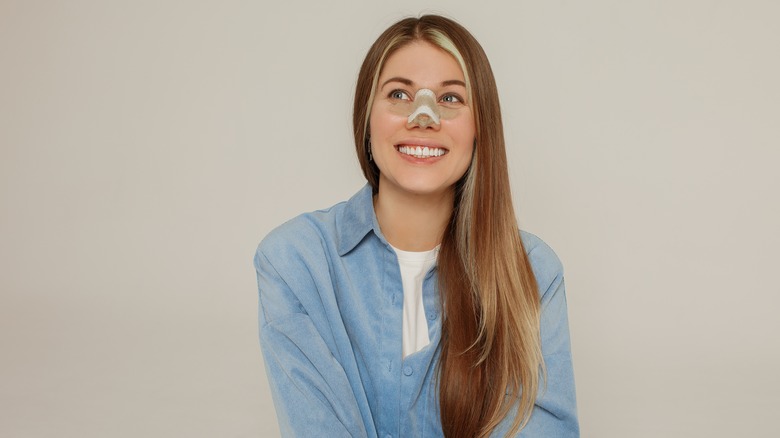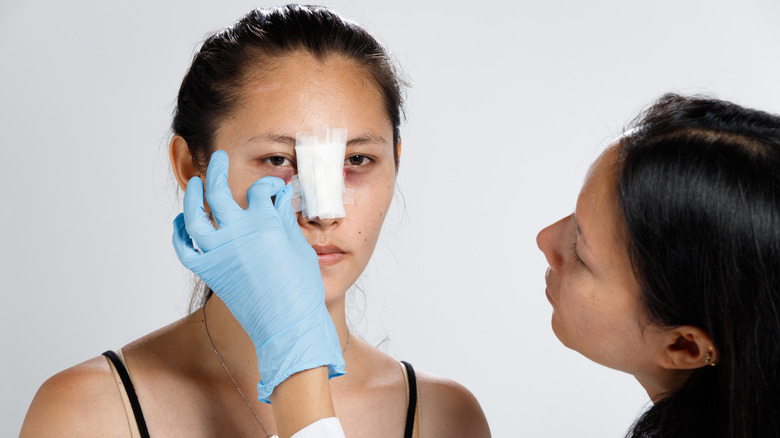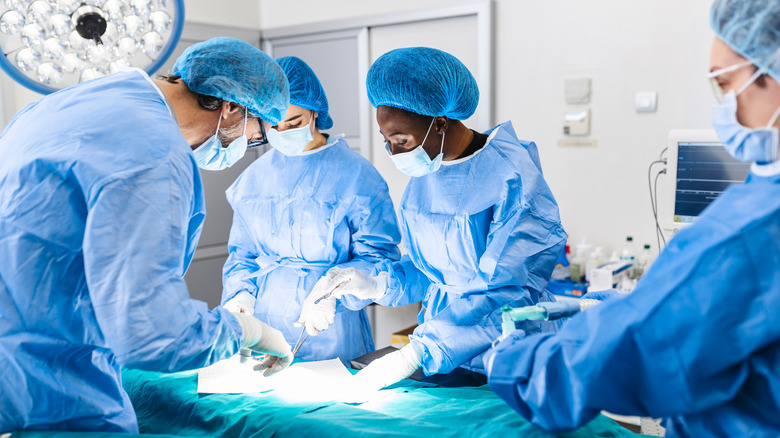Everything You Need To Know About Rhinoplasty
As one of the most popular cosmetic procedures, rhinoplasty has helped countless people achieve their ideal facial appearance. If you're considering this procedure, it's important to have a clear understanding of what it involves and what you can expect. Here's everything you need to know about rhinoplasty.
Rhinoplasty is a surgical procedure that alters the shape of the nose (via Mayo Clinic). It can be used to correct defects or deformities, or to improve the appearance of the nose for cosmetic reasons. There are many reasons someone may want to get this procedure. According to The Houston Center for Facial Plastic Surgery, some of these reasons include chronic sinus problems, a cleft lip, or a deviated nasal septum. Some cosmetic reasons people might want this procedure include having a bulbous or hooked nose, a nose that is too small or too large in relation to the rest of the face, or asymmetry. The surgery is usually performed under general anesthesia, which means that you'll be asleep during the procedure.
What happens during rhinoplasty surgery?
To prep for rhinoplasty, your surgeon will administer either general anesthesia or local anesthesia with sedation. Once you're asleep or numb, the surgeon will make incisions in the skin of your nose (via Artesia Plastic Surgery). Through these incisions, the surgeon will be able to access the bone and cartilage underneath. They may use a technique called "open rhinoplasty," which involves making an incision across the columella, or the strip of tissue that separates your nostrils. Or, they may use what's called a "closed rhinoplasty," which means making incisions inside the nostrils.
Once the surgeon has access to the underlying structures of your nose, they can start shaping it to achieve the desired result. This may involve breaking the bone and resetting it, removing or grafting cartilage, or making adjustments to the soft tissues. In some cases, the surgeon may place implants made of synthetic materials to achieve the desired outcome. Once the surgeon is happy with the shape of your nose, they will close the incisions using either dissolvable stitches or metal clips. A splint will also be placed on your nose to help support it as it heals.
What can I expect after surgery?
After rhinoplasty surgery, you can expect some swelling and bruising around your eyes (via Government of Alberta). This usually lasts for a week or two. You may also have a bloody drainage coming from your nose for the first few days. Your surgeon will likely prescribe pain medication to help you manage any discomfort.
It's important to follow your surgeon's instructions for care after surgery. This will usually involve keeping your head elevated, applying ice packs, and avoiding strenuous activity. You may also have to avoid blowing your nose for a few weeks. Most people feel ready to return to their normal activities within two weeks. However, it can take up to a year for the final results of the surgery to be visible. There are a few standard things you can do to recover from surgery. These include maintaining good hygiene, avoiding smoking and drinking alcohol, staying hydrated, eating healthy foods, and getting plenty of rest. You should also avoid exposing yourself to extreme temperatures, both hot and cold.
Are there any risks associated with rhinoplasty?
As with any surgical procedure, there are some risks associated with rhinoplasty. These include bleeding and infection. Your risk of these issues will be significantly lower if you have your surgery done by a reputable surgeon and follow your aftercare instructions (via The National Library of Medicine). Some people may also experience adverse reactions to anesthesia, which can include everything from nausea and vomiting to more serious issues like heart arrhythmias (via The American Society of Plasic Surgeons).
It's also possible for people to experience unsatisfactory results from rhinoplasty surgery. This could be due to a number of factors, such as inadequate healing, poor surgical technique, or unrealistic expectations. If you're unhappy with the results of your surgery, you may need to undergo revision surgery to correct the issue.
Rhinoplasty is a relatively safe procedure with a low risk of complications. However, as with any surgery, there are some risks involved. These risks will be discussed with you prior to your surgery so that you can make an informed decision about whether or not to proceed. If you're considering rhinoplasty, be sure to consult with a board-certified plastic surgeon. They will be able to answer any questions you have and help you decide if this is the right procedure for you.
What should you look for in a surgeon?
When you're looking for a surgeon to perform your rhinoplasty, it's important to choose someone who is board-certified and has experience performing this type of surgery. You can ask your doctor for recommendations or search for surgeons online. Once you've found a few surgeons you're interested in, be sure to schedule consultations so that you can get a better idea of their credentials and bedside manner, according to The American Board of Cosmetic Surgery.
It's also important to make sure you're comfortable with the surgeon's proposed plan for your surgery. Ask them to explain the procedure in detail and show you before-and-after photos of patients they've performed surgery on. This will help you get a better idea of what to expect from the surgery. You should also be sure to ask about pricing. Depending on the reason for your surgery, it may or may not be covered by your insurance. Surgeries can be quite expensive and you don't want to experience sticker shock after you've picked a surgeon and set a date for your surgery.
The most common plastic surgery procedures
There are a variety of different plastic surgery procedures that people can undergo. While rhinoplasty is one of the most popular, there are many other popular procedures. Some of the most common include breast augmentation, liposuction, and facelifts (via Johns Hopkins Medicine). These procedures can help people achieve their desired appearance and improve their self-confidence.
Breast augmentation is a surgical procedure that involves placing implants in the breasts to increase their size. This is often done for cosmetic reasons but can also be done to reconstruct the breasts after surgery or trauma. Liposuction is a surgery that removes excess fat from the body. It's often used to treat areas like the thighs, stomach, and arms. Facelifts are surgeries that help to tighten the skin and muscles of the face to create a more youthful appearance. If you're interested in undergoing plastic surgery, be sure to consult with a board-certified surgeon to discuss your options.

